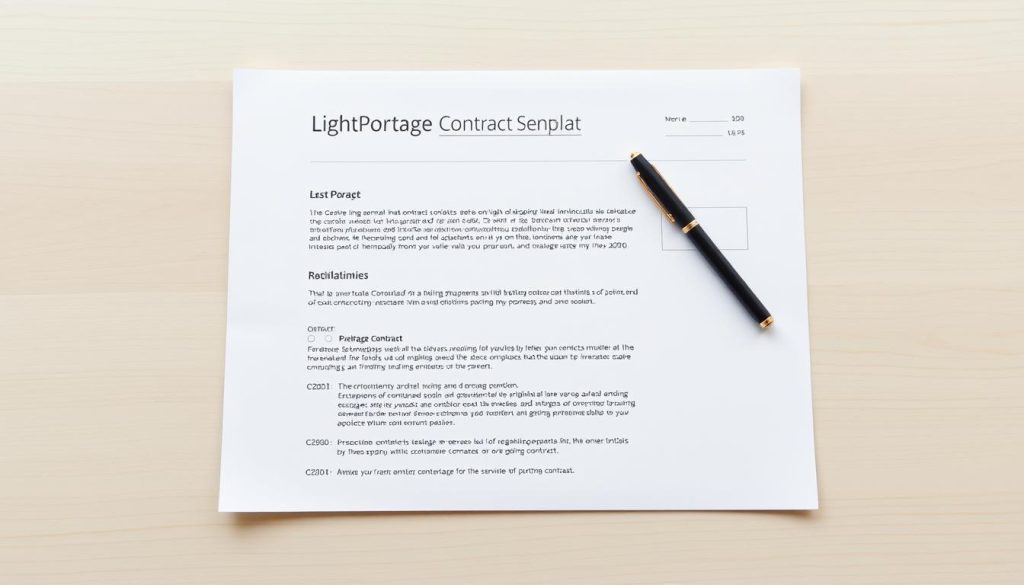Picture this: You’ve just landed a dream project. The client seems perfect, the work aligns with your skills, and the pay is fair. But weeks later, the scope balloons, deadlines shift, and payment stalls. Sound familiar? Many independent professionals face this frustration—not because of bad intentions, but because trust alone isn’t a strategy. That’s where a well-crafted agreement becomes your safety net.
A clear, legally binding document defines responsibilities for both parties. It outlines deliverables, timelines, and compensation while minimizing miscommunication. Think of it as a roadmap: everyone knows the route, avoiding costly detours. For businesses, it ensures quality standards. For freelancers, it safeguards income and professional boundaries.
Whether you’re negotiating your first project or refining existing processes, understanding core terms is non-negotiable. From intellectual property clauses to termination conditions, each detail builds mutual respect. Let’s explore how to create agreements that foster collaboration—not conflict.
Table of Contents
Key Takeaways
- Freelance agreements protect both parties by clarifying expectations and obligations.
- Clearly defined scope prevents « scope creep » and ensures fair compensation.
- Payment terms and deadlines reduce financial disputes.
- Legal safeguards address confidentiality and ownership of work.
- Flexible termination clauses maintain professionalism if partnerships shift.
Understanding Freelance Contracts
Clear documentation forms the backbone of successful collaborations. A well-structured independent contractor agreement acts as both shield and compass, guiding projects while protecting all involved parties.
Defining the Framework
These documents outline specific deliverables, timelines, and compensation structures. They clarify ownership of intellectual property and confidentiality requirements. By detailing job responsibilities, they reinforce legal distinctions between temporary collaborators and permanent employees.
Why Precision Matters
Vague language creates financial risks. One study found 42% of project disputes stem from unclear terms. A precise agreement prevents scope creep by defining exact boundaries. It also secures payment schedules, reducing delays that strain professional relationships.
For businesses, these documents ensure quality standards. For specialists, they protect income streams and work-life balance. Consider how self-employed contract work structures provide stability while maintaining flexibility.
Effective agreements foster trust through transparency. They transform assumptions into actionable plans, letting both sides focus on results rather than misunderstandings.
Key Components of Effective Freelance Contracts

Strong working relationships thrive on clarity. At their core, successful partnerships rely on documents that outline precisely what needs to be done, when it will happen, and how everyone benefits. Let’s break down the non-negotiable elements that transform vague ideas into actionable plans.
Scope of Work and Deliverables
Defining the scope work acts as your project’s blueprint. Start by listing:
- Exact tasks included (and excluded)
- Quality standards for each output
- Approval processes for revisions
A marketing consultant might specify “three blog posts of 1,200 words each” rather than “content creation.” This precision prevents endless revision requests. As one legal advisor notes: “Vague descriptions invite disputes—specificity builds trust.”
Payment Terms and Milestones
Structured payment terms keep collaborations financially healthy. Consider:
- Deposit percentages before work begins
- Milestone triggers tied to deliverables
- Late fees for overdue payments
For example, a web designer could link 30% payment to wireframe approval. This approach aligns compensation with progress. Businesses using milestones report 67% fewer payment delays, according to recent surveys.
Balancing the project’s demands with fair compensation creates mutual respect. Clear terms let both sides focus on results—not misunderstandings.
Drafting Your Freelance Contract

Creating agreements that work requires structure without stifling creativity. This is where templates become your secret weapon—they provide guardrails while leaving room for customization.
Utilizing Templates for Clarity and Efficiency
Pre-built frameworks cut drafting time by 60% according to legal tech reports. A quality contract template ensures you never forget critical clauses like payment schedules or intellectual property rights. We recommend starting with these steps:
- Choose industry-specific formats matching your project type
- Fill placeholder fields with exact deliverables and deadlines
- Highlight sections needing client review (payment terms, termination)
Customization is key. A graphic designer might add font licensing details, while a developer could specify code ownership terms. « Templates aren’t one-size-fits-all—they’re launchpads for precision, » notes a Paris-based legal consultant.
Set quarterly reminders to update your contract template. Market changes or new regulations might require adjustments. This proactive approach keeps your agreements watertight while maintaining professional relationships.
By streamlining the writing process, you can focus on what matters—delivering exceptional work with clear boundaries. Templates transform complexity into clarity, one project at a time.
Protecting Your Business and Freelance Relationship
In the digital age, safeguarding creative assets is as crucial as delivering quality work. Strategic clauses create trust while shielding sensitive data and creative outputs. Let’s explore how to balance protection with professionalism.
Confidentiality and Intellectual Property Rights
Non-disclosure agreements form your first defense. They prevent leaks of trade secrets, client lists, or proprietary methods. A 2023 legal survey found 78% of data breaches occurred through external collaborators lacking proper confidentiality clauses.
Intellectual property rights determine who owns created content. Clearly state whether designs, code, or written materials transfer fully to the company upon payment. For example, software developers often retain license rights unless specified otherwise.
Termination Clauses and Exit Strategies
Even successful partnerships sometimes need clean exits. Effective termination clauses outline conditions for ending collaborations—like missed deadlines or breached terms. They should include:
- Notice periods (14-30 days standard)
- Final payment requirements
- Post-termination confidentiality obligations
| Termination Type | Notice Period | Penalties |
|---|---|---|
| Breach of Contract | Immediate | Up to 15% project value |
| Mutual Agreement | 7 days | None |
| Non-Payment | 5 business days | 2% daily late fee |
Penalty provisions discourage bad faith actions. Late payment fees incentivize timely transfers, while IP infringement fines protect property rights. These measures help secure your collaboration framework without straining relationships.
Well-crafted protections benefit both parties. They allow creative freedom within defined boundaries, fostering long-term partnerships built on respect and security.
Optimizing Your Freelance Contracts: Best Practices
The foundation of a smooth project lies in well-defined expectations. When both parties understand their roles from day one, the relationship thrives on transparency rather than guesswork. Start by outlining deliverables in phases—this creates natural checkpoints to review progress and address changes early.
Establishing Clear Expectations
Set realistic deadlines that account for feedback loops. A graphic designer might allocate 48 hours for client revisions within the project schedule. This approach prevents rushed work while respecting everyone’s time.
Payment structures need equal clarity. Break payments into milestones tied to deliverables. For example:
- 30% deposit upon signing
- 40% after prototype approval
- 30% upon final delivery
Automate invoices to align with these stages. Tools like FreshBooks or QuickBooks send reminders, reducing payment delays by 52% according to 2023 fintech data. This system keeps income predictable and cash flow steady.
Include a clause for scope adjustments. Specify how additional requests impact timelines and costs. One legal expert advises: « Flexibility clauses prevent resentment—they turn potential conflicts into structured negotiations. »
Regular check-ins reinforce the relationship. Share progress updates weekly, and document all changes in writing. For complex projects, consider expert guidance to refine your agreement strategy. Clear communication isn’t just polite—it’s profitable.
Leveraging Digital Tools and Templates
Modern professionals deserve systems that work as hard as they do. Digital solutions now handle repetitive tasks, letting you focus on high-value work. From instant invoicing to version-controlled agreements, technology bridges efficiency gaps that once drained productivity.
Streamlining Payments and Invoicing
Platforms like Wise Business transform how you get paid. They offer local bank details for 30+ countries, slashing international transfer fees by up to 19x. Automated invoice generation syncs with accounting software, reducing manual errors.
Batch payment features let businesses compensate multiple workers simultaneously. One Paris-based designer reported cutting payment processing time by 70% using these tools. As financial expert Léa Martin notes: « Automation turns payment delays into relics of the past. »
Automated Contract Management Solutions
Cloud-based systems track deadlines, revisions, and signatures in real time. Version control ensures everyone references the latest document, while AI alerts flag approaching milestones. These platforms integrate with CRM tools, creating seamless workflows.
For businesses managing global teams, centralized dashboards provide instant visibility. A 2023 study showed firms using these tools resolved 83% of document-related disputes faster. This efficiency lets teams optimize management strategies while maintaining compliance.
By adopting these systems, professionals reclaim 12-15 hours monthly—time better spent growing their business or refining craft. Technology isn’t just convenient—it’s competitive advantage.
Conclusion
Trust in professional relationships is built on clear expectations. Well-structured contracts serve as strategic tools, protecting both specialists and companies by defining roles and deliverables. These documents transform uncertainty into actionable plans, ensuring everyone focuses on results rather than disputes.
Key elements like payment schedules, project scope, and termination conditions require precise detail. Digital templates streamline creation while maintaining legal compliance, saving time for creative work. Automated systems further enhance efficiency by tracking deadlines and payments.
Properly crafted agreements distinguish independent collaborators from traditional employee relationships. This clarity prevents misclassification risks while safeguarding intellectual property rights. Regular reviews keep terms aligned with evolving business needs and regulations.
You gain stability through defined boundaries. Businesses maintain quality standards without overstepping professional autonomy. By prioritizing transparent agreements, both parties build partnerships that thrive on mutual respect and shared success.
FAQ
What’s the most critical clause to include in a freelance agreement?
The termination clause protects both parties by outlining conditions for ending the partnership. It should specify notice periods, final payment obligations, and procedures for handing over deliverables or intellectual property.
How detailed should the scope of work section be?
Define deliverables, timelines, and revision limits explicitly. For example, state “three website design mockups by June 15” instead of vague terms. Clarity minimizes disputes and ensures alignment on project expectations.
Can I use templates from platforms like HelloSign or PandaDoc?
Yes. Templates from trusted providers streamline drafting while ensuring legal compliance. Customize them to reflect your niche, payment terms, and intellectual property rights. Always review clauses with a legal professional.
What happens if a client misses a payment deadline?
Include late fees (e.g., 1.5% monthly interest) and payment recovery steps in your contract. Tools like QuickBooks or FreshBooks automate reminders, while milestones tied to invoices ensure cash flow stays predictable.
How do I protect intellectual property rights in a contract?
Specify ownership transfer terms—for example, rights shift to the client only after full payment. Use confidentiality clauses to safeguard sensitive data. Platforms like LegalZoom offer pre-built IP clauses for customization.
Should contracts include penalties for missed deadlines?
Yes, but balance accountability with flexibility. Define consequences like reduced fees for delays caused by the freelancer, while allowing renegotiation for client-driven holdups. This fosters professionalism without straining relationships.
How do I handle scope changes mid-project?
Require written change orders signed by both parties. Detail adjustments to timelines, costs, and deliverables. Tools like Trello or Asana help track revisions, ensuring transparency and preventing “scope creep.”
What’s the benefit of automated invoicing tools?
Platforms like Wave or Zoho Invoice reduce administrative work, auto-send payment reminders, and sync with contract milestones. They also provide audit trails, simplifying tax preparation and financial reporting.





